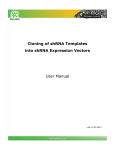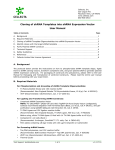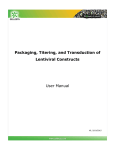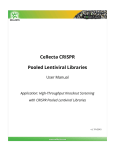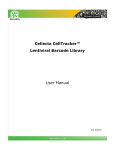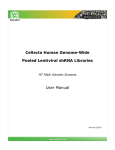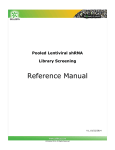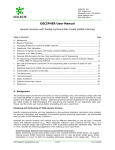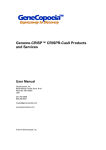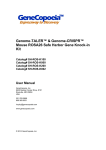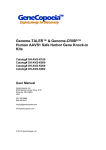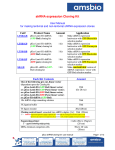Download Cellecta-Manual-shRNA-sgRNA
Transcript
Cloning of shRNA and sgRNA Templates into Cellecta Expression Vectors User Manual V5, 7/16/15 shRNA & sgRNA Cloning www.cellecta.com Contents A. Background .................................................................................................................................................2 B. Required Materials .....................................................................................................................................2 C. Design of shRNA Template Oligonucleotides for shRNA Expression Vectors.....................................3 Forward oligo ..............................................................................................................................................3 Reverse oligo: ..............................................................................................................................................3 D. Design of sgRNA Template Oligonucleotides for CRISPR Expression Vectors ....................................3 Sense Oligo ..................................................................................................................................................3 Antisense Oligo ...........................................................................................................................................4 E. Cloning of shRNA or sgRNA Template Oligonucleotides into an Expression Vector .........................4 F. Identify clones with the target shRNA or sgRNA template ....................................................................6 G. Purify Plasmid shRNA or sgRNA Construct .............................................................................................7 H. Technical Support .......................................................................................................................................8 I. Safety Guidelines ........................................................................................................................................8 J. Terms and Conditions ............................................................................................................................. 10 A. Background The protocols below provide the instructions on how to phosphorylate shRNA or sgRNA template oligos, ligate them to cloning vectors, transform competent cells, and grow plasmid DNA to generate plasmid expression constructs. For packaging of constructs into lentiviral particles, please refer to the User Manual for Packaging and Transduction of Lentiviral Constructs. Please read the entire user manual before proceeding with your experiment. B. Required Materials For Digestion of Uncut Cloning Vector • BbsI enzyme (Recommended: New England BioLabs, Cat.# R0539L) For Phosphorylation and Annealing of shRNA or sgRNA Template Oligonucleotides • T4 Polynucleotide Kinase and 10X Reaction Buffer (Recommended: New England BioLabs T4 Polynucleotide Kinase, 10 U/μl, Cat. # M0201S) • rATP (Recommended: GE/Amersham, Cat. # 27-2056-01) For Ligating and Transforming shRNA or sgRNA Constructs • Linearized Cellecta shRNA Expression Vector or CRISPR Expression Vector [email protected] 2 of 11 v5, 7/16/15 shRNA & sgRNA Cloning www.cellecta.com • T4 DNA Ligase and 10X Ligation Reaction Buffer (Recommended: New England BioLabs, T4 DNA Ligase, 400 U/µl. Cat. # M0202S): Before using, dilute T4 DNA-ligase 10-fold with 1X T4 DNA ligase buffer to 40 U/µl.) • Competent E. coli cells (RecA-) (Recommended: Invitrogen, OmniMAX™ 2 T1 Phage-resistant cells, Cat. # C8540-03) • Petri plates containing LB Agar media with 100 µg/ml Ampicillin or Carbenicillin For Screening shRNA or sgRNA Inserts • Taq DNA polymerase, and 10X reaction buffer (Recommended: BDB Clontech Titanium™ Taq DNA polymerase, Cat. # 639208) • dNTP mix (Recommended: GE/Amersham, dNTP set, Cat. # 27-2035-01) • Thermal Cycler • 3% 1X TAE Agarose gel • PCR Screening Primers for your vector* * Please check the Product Analysis Certificate (PAC) that came with your product. For Purifying shRNA and Constructs after Cloning • • Plasmid purification kit (Recommended: QIAGEN Endotoxin-free Plasmid Kit. The following kit combinations can be used for Midi scale preparation of endotoxin-free DNA: § QIAfilter Plasmid Midi Kit, Cat. # 12243, and EndoFree Plasmid Maxi Kit, Cat. # 12362 § QIAfilter Plasmid Midi Kit, Cat. # 12243, and EndoFree Plasmid Buffer Set, Cat. # 19048 Please visit the QIAGEN website to download the specialized protocol that is not contained in the user manual: http://www1.qiagen.com/literature/protocols/pdf/QP15.pdf C. Design of shRNA Template Oligos for shRNA Expression Vectors The general design of shRNA template oligonucleotides is: 5’-ACCGG-(21sense)-(Stem-Loop-Stem)-(21antisense)-TTTT-3’ Sense oligo: 5’-accgGNNNNNNNNNNNNNNNNNNNNNGTTAATATTCATAGCNNNNNNNNNNNNNNNNNNNNNTTTT-3’ Antisense oligo: 5’-cgaaAAAANNNNNNNNNNNNNNNNNNNNNGCTATGAATATTAACNNNNNNNNNNNNNNNNNNNNNC-3’ D. Design of sgRNA Template Oligos for CRISPR Expression Vectors The general design of sgRNA template oligonucleotides is: 5’-ACCG-(20nt guide)-(scaffold/tracrRNA)-TTTT-3’ [email protected] 3 of 11 v5, 7/16/15 shRNA & sgRNA Cloning www.cellecta.com Sense Oligo: 5’accgNNNNNNNNNNNNNNNNNNNNgttttagagctagaaatagcaagttaaaataaggctagtccgttatcaact tgaaaaagtggcaccgagtcggtgctttt-3’ Antisense Oligo: 5’cgaaaaaagcaccgactcggtgccactttttcaagttgataacggactagccttattttaacttgctatttctag ctctaaaacNNNNNNNNNNNNNNNNNNNN-3’ Guide: NNNNNNNNNNNNNNNNNNNN Scaffold/tracrRNA: 5’gttttagagctagaaatagcaagttaaaataaggctagtccgttatcaacttgaaaaagtggcaccgagtcggtg c-3’ E. Cloning of shRNA or sgRNA Template Oligonucleotides into an Expression Vector 1. Phosphorylate and Anneal the shRNA Template Oligonucleotides Note: This protocol was developed for regular non-phosphorylated oligos. If your oligonucleotides are already phosphorylated, dilute them to 10 µM in 1X T4 polynucleotide kinase buffer, heat at 95°C for 2 min and anneal as in steps 1.d-1.e below. a. Dissolve the shRNA or sgRNA template oligonucleotides in an appropriate amount of deionized water to a final concentration of 20 µM. b. Set up 20 µl phosphorylation/annealing reactions for each shRNA or sgRNA template: 1 µl Sense Strand shRNA or sgRNA template oligo (20 µM) * 1 µl Antisense Strand shRNA or sgRNA template oligo (20 µM) * 2 µl 10X T4 Polynucleotide Kinase Buffer 2 µl 5 mM ATP 13 µl 1 µl 20 µl Deionized water T4 Polynucleotide Kinase (10 U/µl) Total volume * For the insert-minus control, use 2 µl deionized water in place of the sense and antisense strands. c. Incubate the phosphorylation reaction at 37°C for 30 minutes in a thermal cycler. d. Heat the reaction mix to 95°C for 2 min in a thermal cycler. e. Turn off the thermal cycler and let it cool to room temperature. [email protected] 4 of 11 v5, 7/16/15 shRNA & sgRNA Cloning www.cellecta.com f. Take a 2 µl aliquot from the reaction (1 µM shRNA or sgRNA template), and make a 1:5 dilution by adding 8 µl of 1X T4 Kinase buffer. Mix well. g. Use 0.5 µl of the diluted shRNA or sgRNA template (0.2 µM) for the following ligation reaction. 2. Ligate the shRNA or sgRNA Template into Linearized shRNA or sgRNA Lentivector a. Set up 10 µl ligation reactions for each phosphorylated shRNA or sgRNA template as follows: 1.0 µl Linearized shRNA or sgRNA Expression Vector (10 ng/µl) (see Required Materials) 0.5 µl Phosphorylated ds shRNA or sgRNA template (step 1; 0.2 µM) * 1.0 µl 10X T4 DNA Ligase Buffer 6.5 µl Deionized water 1.0 µl T4 DNA ligase (40 U/µl) ** 10.0 µl Total volume * For negative control use insert-minus. ** Dilute T4 DNA ligase (400 U/µl) 10-fold to 40 U/µl with 1X T4 DNA ligase buffer if you are using New England BioLabs enzyme. b. Incubate the ligation reaction at 16°C for 1-2 hrs. 3. Transform E. coli with the ligation product a. For each shRNA or sgRNA template, use the whole volume of ligation product for transformation. b. Follow the manufacturer’s protocol for transforming the competent cells. c. Plate an appropriate amount of cells on LB plates with 100 µg/ml ampicillin or carbenicillin and grow overnight at 37°C. d. You should expect to get at least 10-fold more colonies in experimental samples in comparison with negative control (vector-only ligation reaction). [email protected] 5 of 11 v5, 7/16/15 shRNA & sgRNA Cloning www.cellecta.com F. Identify clones with the target shRNA or sgRNA template 1. Prepare colony cultures a. Randomly pick up 10 well-separated colonies from each plate, and grow each clone in 100 µl of LB Broth with 100 µg/ml ampicillin or carbenicillin at 37°C for 2 hours with shaking. b. Take 1 µl of each bacteria culture for PCR screening and continue to grow the culture for another 6 hours. c. Store the bacterial culture at 4°C. 2. Screen for shRNA or sgRNA template inserts a. Prepare a PCR master mix for each clone you would like to screen for the presence of an shRNA or sgRNA template insert as follows: 1 rxn 10 rxn Composition 0.5 µl 5 µl Forward PCR Primer (10 µM)* 0.5 µl 5 µl Reverse PCR Primer (10 µM)* 0.5 µl 5 µl 50X dNTP mix (10 mM of each) 2.5 µl 25 µl 19.5 µl 195 µl 0.5 µl 5 µl 24.0 µl 240 µl 10X PCR Reaction Buffer Deionized water Taq DNA Polymerase (5 U/µl) Total volume *See the Product Analysis Certificate for your plasmid to find the required primer sequences. b. Mix the master mix very well and aliquot 24 µl into each well of a 96-well PCR plate or individual tubes. c. Add 1 µl of each bacterial culture from B.1 into each well or tube from B.2.b. Mix. d. Proceed with PCR using the following program: 94°C, 4 min 94°C, 0.5 min, then 68°C, 1 min 68°C, 2 min 1 cycle 25 cycles 1 cycle e. Take 5 µl of PCR product from Step d and run it on a 3% agarose/EtBr gel in 1X TAE buffer. f. Confirm identity of shRNA or sgRNA template inserts by sequence analysis of positive PCR products using the Forward PCR primer. [email protected] 6 of 11 v5, 7/16/15 shRNA & sgRNA Cloning www.cellecta.com G. Purify Plasmid shRNA or sgRNA Construct 1. Take 15 µl of each positive bacteria culture, inoculate each clone in 10 ml of LB broth media with 100 µg/ml ampicillin or carbenicillin, and grow overnight at 37°C with shaking. 2. Purify shRNA or sgRNA lentivector construct plasmid DNA in Midi or Maxi scale using an Endotoxin-free plasmid purification kit. [email protected] 7 of 11 v5, 7/16/15 shRNA & sgRNA Cloning www.cellecta.com H. Technical Support For additional information or technical assistance, contact us by phone or email: Phone: +1 (650) 938-3910 Toll-Free: +1 (877) 938-3910 Fax: +1 (650) 938-3911 E-mail: Technical Support: [email protected] General Information: [email protected] Sales: [email protected] Orders: Postal Mail: [email protected] Cellecta, Inc. 320 Logue Ave. Mountain View, CA 94043 For the latest technical news and updates, visit Cellecta’s blog at: http://www.cellecta.com/company/blog-news/ I. Safety Guidelines The HIV-based lentivector system is designed to maximize its biosafety features, which include: • A deletion in the enhancer of the U3 region of 3’ΔLTR ensures self-inactivation of the lentiviral construct after transduction and integration into genomic DNA of the target cells. • The RSV promoter upstream of 5’LTR in the lentivector allows efficient Tat-independent production of lentiviral RNA, reducing the number of genes from HIV-1 that are used in this system. • Number of lentiviral genes necessary for packaging, replication and transduction is reduced to three (gag, pol, rev). The corresponding proteins are expressed from different plasmids lacking packaging signals and share no significant homology to any of the expression lentivectors, pVSV-G expression vector, or any other vector to prevent generation of recombinant replication-competent virus. • None of the HIV-1 genes (gag, pol, rev) are present in the packaged lentiviral genome, as they are expressed from packaging plasmids lacking packaging signal—therefore, the lentiviral particles generated are replication-incompetent. • Lentiviral particles will carry only a copy of your expression construct. [email protected] 8 of 11 v5, 7/16/15 shRNA & sgRNA Cloning www.cellecta.com Despite the above safety features, use of HIV-based vectors falls within NIH Biosafety Level 2 criteria due to the potential biohazard risk of possible recombination with endogenous lentiviral sequences to form self-replicating virus or the possibility of insertional mutagenesis. For a description of laboratory biosafety level criteria, consult the Centers for Disease Control Office of Health and Safety Web site at: http://www.cdc.gov/biosafety/publications/bmbl5/bmbl5_sect_iv.pdf It is also important to check with the health and safety guidelines at your institution regarding the use of lentiviruses and follow standard microbiological practices, which include: • Wear gloves and lab coat at all times when conducting the procedure. • Always work with lentiviral particles in a Class II laminar flow hood. • All procedures are performed carefully to minimize the creation of splashes or aerosols. • Work surfaces are decontaminated at least once a day and after any spill of viable material. • All cultures, stocks, and other regulated wastes are decontaminated before disposal by an approved decontamination method such as autoclaving. Materials to be decontaminated outside of the immediate laboratory area are to be placed in a durable, leakproof, properly marked (biohazard, infectious waste) container and sealed for transportation from the laboratory. [email protected] 9 of 11 v5, 7/16/15 shRNA & sgRNA Cloning www.cellecta.com J. Terms and Conditions Cellecta, Inc. Limited License Cellecta grants the end user (the “Recipient”) of the CRISPR Pooled Lentiviral sgRNA Libraries and Vector (the “Product”) a nontransferable, non-exclusive license to use the reagents for internal research use only as described in the enclosed protocols; in particular, research use only excludes and without limitation, resale, repackaging, or use for the making or selling of any commercial product or service without the written approval of Cellecta, Inc. - separate licenses are available for non-research use or applications. The Product is not to be used for human diagnostics or included/used in any drug intended for human use. Care and attention should be exercised in handling the Product by following appropriate research laboratory practices. Cellecta’s liability is expressly limited to replacement of Product or a refund limited to the actual purchase price. Cellecta’s liability does not extend to any damages arising from use or improper use of the Product, or losses associated with the use of additional materials or reagents. This limited warranty is the sole and exclusive warranty. Cellecta does not provide any other warranties of any kind, expressed or implied, including the merchantability or fitness of the Product for a particular purpose. Use of the Product for any use other than described expressly herein may be covered by patents or subject to rights other than those mentioned. Cellecta disclaims any and all responsibility for injury or damage that may be caused by the failure of the Recipient or any other person to use the Product in accordance with the terms and conditions outlined herein. The Recipient may refuse these licenses by returning the enclosed Product unused. By keeping or using the enclosed Product, you agree to be bound by the terms of these licenses. The laws of the State of California shall govern the interpretation and enforcement of the terms of these Licenses. Limited Use Label Licenses The Recipient acknowledges that the Product has been developed by Cellecta based on licenses from Third Parties and agrees with the Terms of Limited Use for the Recipient provided by the Third Parties: Life Technologies Corporation End-User Label License for the use of Lentiviral Expression System: “This product or service (based upon the Lentiviral Expression System) is sublicensed from Life Technologies Corporation under U.S. Patent Nos. 5,686,279; 5,834,256; 5,858,740; 5,994,136; 6,013,516; 6,051,427; 6,165,782; 6,218,187; 6,428,953; 6,924,144; 7,083,981 and 7,250,299 and corresponding patents and applications in other countries for internal research purposes only. Use of this technology for gene therapy applications or bioprocessing other than for nonhuman research use requires a license from GBP IP, LLC. Please contact GBP IP, LLC 537 Steamboat Road, Suite 200, Greenwich, CT 06830. Use of this technology to make or sell products or offer services for consideration in the research market requires a license from Life Technologies Corporation, 5791 Van Allen Way, Carlsbad, CA 92008.” Evrogen IP JSC End-User Label License for the use of lentiviral sgRNA constructs comprising TagRFP-encoded gene: “This product is for internal non-commercial research use only. No rights are conveyed to modify or clone the gene encoding fluorescent protein contained in this product. The right to use this product specifically excludes the right to validate or screen compounds. For information on commercial licensing, contact Evrogen Licensing Department, email: [email protected]”. Cold Spring Harbor Laboratory (CSHL) shRNA or sgRNA Product End-User Label License for use of expression vectors encoding an shRNA or sgRNA Acceptance. This Limited Use License (“License”) contains the exclusive terms and conditions between CSHL and Customer for use of the Product. By opening the Product container or in any other way accessing or using the Product (“Acceptance”), you will create a binding legal contract upon the terms and conditions herein, without modification. Customer's purchase order or similar terms shall not apply to this License. If you are not authorized by Customer to enter into this License or do not agree to all terms and conditions in this License, then you are prohibited from opening the Product container or otherwise accessing or using the Product. Permitted Use. Portions of the Product are covered by US and foreign patent applications or patents and other proprietary intellectual property rights owned by CSHL (“shRNA or sgRNA IP Rights”). Subject to Acceptance and all terms and conditions of this License, sale of the Product to Customer by Seller (acting under its license from CSHL, an “Authorized Sale”) conveys to Customer only the nonexclusive, nontransferable right under the shRNA or sgRNA IP Rights to use the Product solely for Customer's internal research purposes, and only at its facility where the Products are delivered by Seller. Unlicensed Products. Any Product that is acquired other than pursuant to an Authorized Sale (including without limitation, any Product not acquired from Seller) shall be deemed to be an “Unlicensed Product”. This License shall be void and of no effect for Unlicensed Products and shall not convey any express or implied right to make, use or sell Unlicensed Products for any purpose. Restrictions. Customer obtains no right to sublicense it rights, or to use the Product for the benefit of any third party for any commercial purpose (including without limitation, using the Product in connection with providing services to any third party or generating commercial databases). The Product may not be used in vitro or in vivo for any diagnostic, preventative, therapeutic or vaccine application, or used (directly or indirectly) in humans for any purpose. Customer may not isolate, extract, reverse engineer, derive, copy or separately use any component of the Product (such as, for example, any shRNA or sgRNA component) for any commercial purpose (including without limitation, for the purpose of making Products) other than solely for Customer's internal research purposes. Non-Profit Customers. If Customer is a Non-Profit Entity, then the following additional restrictions shall apply: Customer obtains no right to use the Product for any commercial purpose. [email protected] 10 of 11 v5, 7/16/15 shRNA & sgRNA Cloning www.cellecta.com Commercial Customers. If Customer is a Commercial Entity, (unless Customer has already entered into a separate written agreement that has been executed by CSHL, that covers the shRNA or sgRNA IP rights, and that is then currently in effect) then the following additional restrictions shall apply: This License and Customer’s rights hereunder automatically terminate 1 year after delivery of Product to Customer. After 1 year of Product use customer must enter into a separate written agreement with CSHL that covers the shRNA or sgRNA IP rights or Customer shall immediately stop using and destroy all Product in its possession. The Product may not be used to make any mouse that is of a strain of mice for germ line transmission by embryonic transfer of a gene encoding an shRNA or sgRNA that induces suppression of a gene or genes by RNAi. No Transfers. Customer may not distribute or transfer the Product (by license, sale, loan, lease, rental or any other means) to any commercial partner or any other third party for any commercial purpose, except only in the following case. Customer may transfer the unmodified Product to a commercial third party contractor who, pursuant to a written agreement with Customer and only for non-royalty based payment(s), undertakes on behalf of Customer to use the Product solely for Customer’s benefit and internal research purposes, which third party shall not, after termination of such work, retain or receive subsequent rights to possess, access or use any Product (or any results of such work), and from whom Customer receives no payments pursuant to such agreement. Compliance. Customer may only use the Product in compliance with all local, state, federal and other applicable laws, regulations and rules, including without limitation (for uses in the United States), EPA, FDA, USDA and NIH guidelines, Customer may not (directly or indirectly) use the Product, or allow the transfer, transmission, export or re-export of all or any part of the Product or any product thereof, in violation of any export control law or regulation of the United Sates or any other relevant jurisdiction. Disclaimers. THE PRODUCT IS PROVIDED “AS IS” WITHOUT WARRANTY OF ANY KIND. NO WARRANTY IS MADE THAT THE PRODUCT WILL MEET CUSTOMER’S REQUIREMENTS, OR THAT ANY RESULT CAN BE ACHIEVED, OR THAT USE OF THE PRODUCT WILL NOT INFRINGE ANY PATENT OR OTHER PROPRIETARY RIGHT. ALL WARRANTIES, EXPRESS OR IMPLIED, ORAL OR WRITTEN, ARE HEREBY EXPRESSLY DISCLAIMED, INCLUDING WITHOUT LIMITATION, ALL IMPLIED WARRANTIES OF NON-INFRINGEMENT, QUIET ENJOYMENT, MERCHANTABILITY OR FITNESS FOR ANY PARTICULAR PURPOSE AND ALL WARRANTIES ARISING FROM ANY COURSE OF DEALING, COURSE OF PERFORMANCE OR USAGE OF TRADE. Other Uses. Except for the limited use expressly specified above, no other license is granted, no other use is permitted and CSHL retains all rights, title and interests in and to the shRNA or sgRNA IP Rights. Nothing herein confers to Customer (by implication, estoppel or otherwise) any right or license under any patent, patent application or other proprietary intellectual property right of CSHL other than the shRNA or sgRNA IP Rights. For information on purchasing a license to use the Product for longer time periods, in greater quantities or for other purposes, or to practice more broadly under the shRNA or sgRNA IP Rights, or to practice under other CSHL intellectual property rights, please contact the CSHL Office of Technology Transfer at (516) 367-8301. Definitions. “Affiliate” means, at the time of reference thereto, any corporation, company, partnership, joint venture or other entity which controls, is controlled by or is under common control with the subject entity, where “control” means direct or indirect ownership of more than 50% of (i) the outstanding stock or other voting rights entitled to elect directors or (ii) all ownership interests (or, in any country where the local law shall not permit foreign equity participation of 50% or more, then the direct or indirect ownership or control of the maximum percentage of such outstanding stock, voting rights or ownership interests permitted by local law). “Commercial Entity” means any entity or organization other than a Non-Profit Entity. “CSHL” means Cold Spring Harbor Laboratory. “Customer” means the company or other entity or organization that orders, pays for and takes delivery of the Product. “Non-Profit Entity” means any college, university or governmental entity (including without limitation, governmental and quasi-governmental institutes and research laboratories), or any non-profit scientific, research or educational organization that is of the type described in section 501(c)(3) of the Internal Revenue Code or that is qualified under a state nonprofit organization statute. “Product” means a product (including without limitation, expression vectors encoding an shRNA or sgRNA), the design, manufacture or use of which (in whole or in part) is the subject of the shRNA or sgRNA IP Rights, and is deemed to include all components, progeny, reproductions, modified versions and other derivatives thereof. “Seller” means Cellecta, Inc. © 2015 Cellecta, Inc. All Rights Reserved. Terms and Conditions are also available online at http://www.cellecta.com/company/legal-information/terms-and-conditions/. Trademarks CELLECTA is a registered trademark of Cellecta, Inc. [email protected] 11 of 11 v5, 7/16/15











